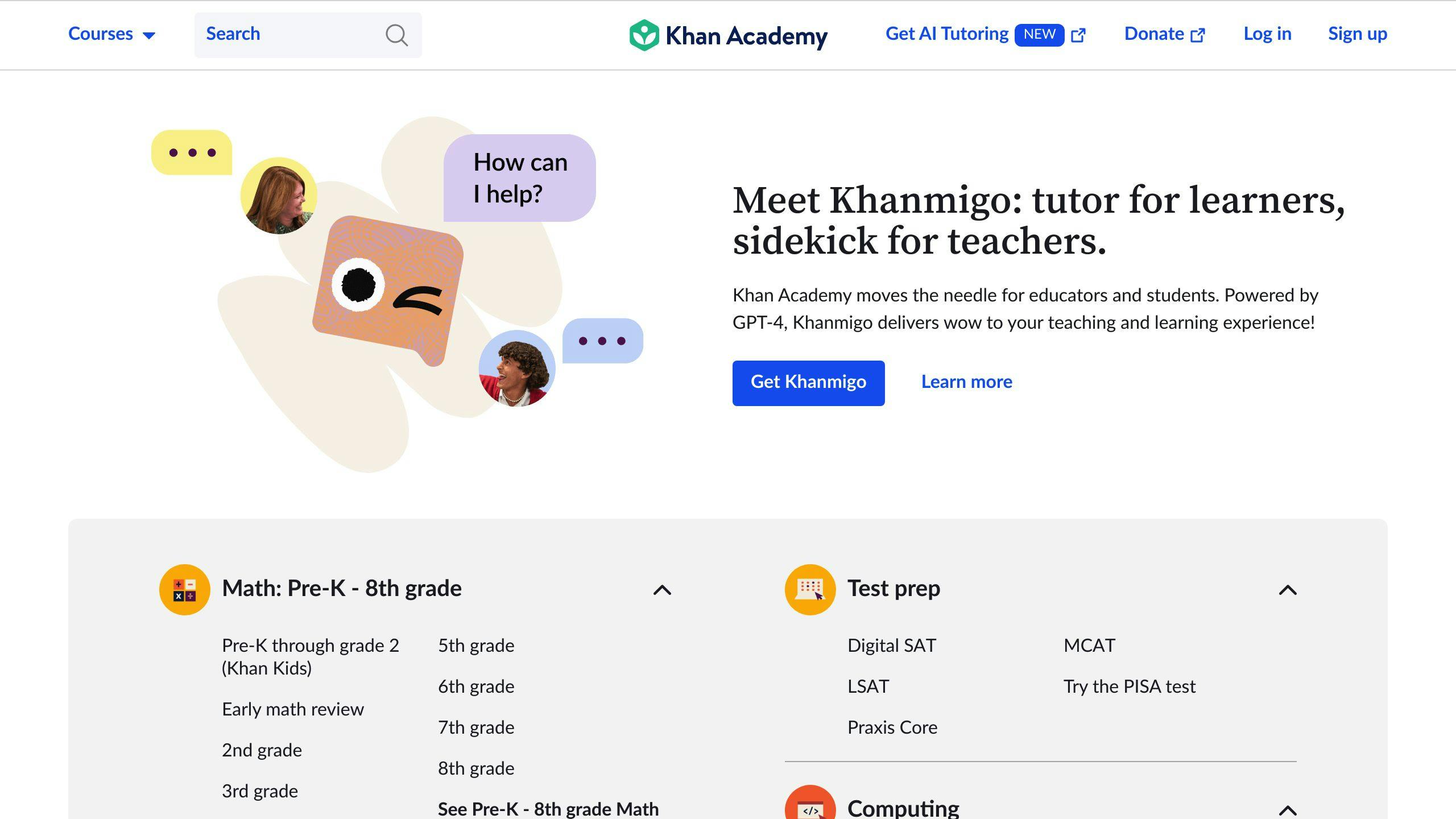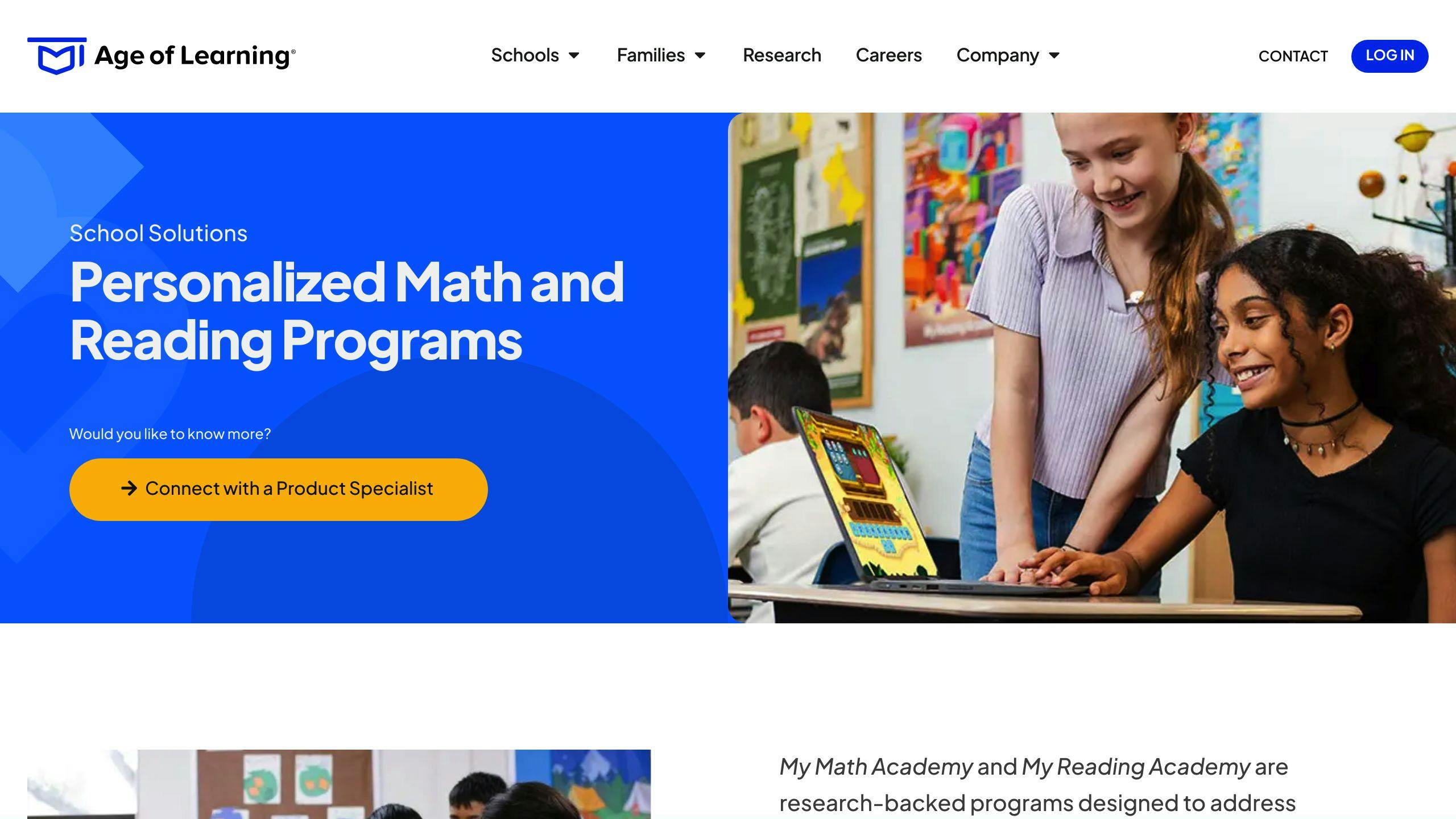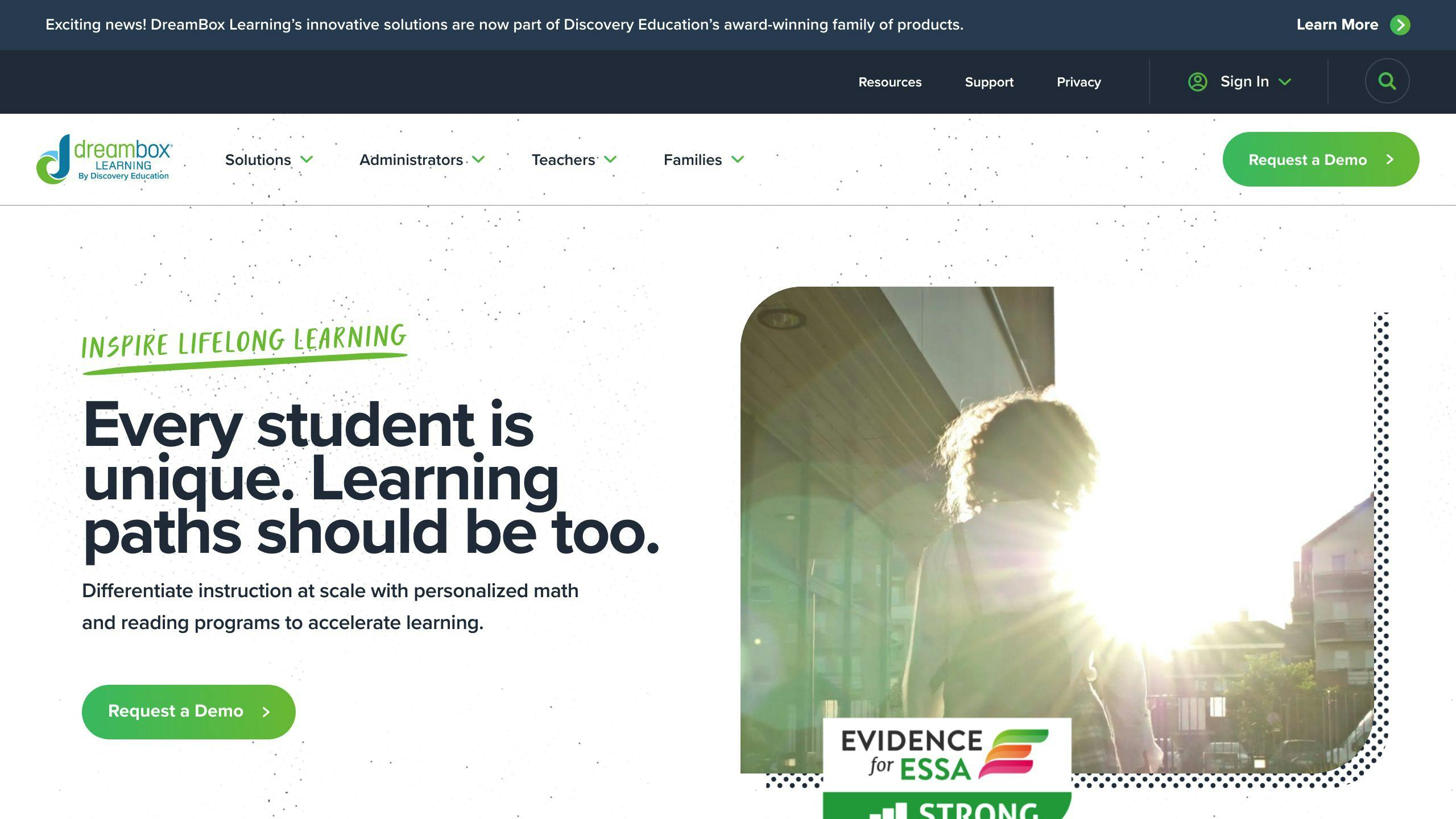
Learning is Personalized: A Parent's Guide
Personalized learning tailors education to meet each student's unique needs, preferences, and pace, offering a more engaging and effective learning experience. Here's a quick guide for parents on personalized learning:
- What is Personalized Learning? A method where education is customized to suit individual student’s strengths, interests, and learning pace.
- Why It Matters: Studies show it can lead to better grades, higher completion rates, and increased student motivation.
- Understanding Your Child's Needs: Identifying your child’s learning style (visual, auditory, kinesthetic), interests, and pace can help in selecting the right resources and methods.
- Choosing a Personalized Learning Platform: Platforms like Khan Academy, Age of Learning, and Dreambox Learning Math offer tailored learning experiences.
- Implementing Personalized Learning at Home: Setting clear goals, establishing a learning schedule, and keeping learning engaging are key steps.
- Measuring Progress: Utilize platform analytics, conduct periodic assessments, and solicit student feedback to gauge and adapt learning strategies.
- Overcoming Obstacles: Strategies for enhancing self-direction and supplementing platform limitations.
Personalized learning is about understanding and adapting to your child’s unique learning journey, using the right tools and approaches to foster an environment where they can thrive.
Why Personalized Learning Matters
Studies show that personalized learning can make students do better:
- Better grades and test scores
- More students finishing school
- Students are more interested and motivated
In one study with 62 schools, students in personalized learning classes did about 8 points better on tests than other students.
Personalized learning is effective because it focuses on what each student needs and likes. This makes learning more interesting, helps students stay curious, and lets them reach their full potential.
Understanding Your Child's Learning Needs
Learning Styles
Every kid learns in their own way, and figuring out your child's style can really help them. There are three main types:
- Visual learners like to see things to understand them. They do well with pictures, charts, and demonstrations.
- Auditory learners learn by listening. They get more from spoken lessons, talks, and discussions.
- Kinesthetic learners need to move and touch things to learn. They like building, moving, and doing activities.
Watch how your child approaches new things to spot their learning style. Talking to their teacher can also give you more insights.
Interests
What your child is interested in can make a big difference in how motivated they are to learn. When they're excited about a topic, they're more likely to work hard.
Talk with your child about what they like. Ask questions like:
- What's your favorite thing to learn about?
- What do you wish you could learn more in school?
- What are your hobbies?
Use their answers to find learning tools and games that match their interests. This can make even tough subjects more fun.
Pace
Kids learn at different speeds. Some pick up new things quickly, while others take more time. It's important to match learning to your child's pace.
If your child learns fast, look for more challenging activities like contests or clubs to keep them interested.
If your child needs more time, talk to their teacher about extra help or special plans like an IEP or 504 plan. Be patient, break down lessons into smaller parts, and give them plenty of time to practice.
Matching the pace of learning helps avoid frustration and keeps learning fun and engaging for your child.
Choosing a Personalized Learning Platform
Finding the right online learning platform can help your child learn in a way that's best for them. You want something that matches their pace, interests, and how they learn best. Here are some good places to start:
Khan Academy

Khan Academy is a free website with lots of video lessons and activities on subjects like math, science, and history.
Key features:
- The difficulty of activities changes based on how well the student is doing
- Parents can see reports on how their child is progressing
- Kids can earn badges and points, which makes learning fun
- You can use it on computers and phones
It's great for kids who like to learn on their own, watching videos and working through topics at their pace.
Age of Learning

This company makes learning programs like ABCMouse and Adventure Academy.
Key features:
- Lessons that fit what kids are supposed to learn in school
- Fun games, books, and songs
- Parents can check on their child's progress
- Good for younger kids, from Pre-K to 8th grade
This platform makes learning fun and adjusts to what your child needs.
Dreambox Learning Math

A math program for kids in kindergarten through 8th grade that changes to help each student.
Key features:
- Changes based on what the student needs right then
- Covers math topics like Fractions and Geometry
- Parents and teachers get reports on progress
- Good for extra math practice or learning more at home
Dreambox is all about helping kids get better at math, in a way that's just right for them.
Implementing Personalized Learning
Set Goals
Working together with your child to make learning goals is a great first step for personalized learning at home. Here's how to do it:
- Talk about what your child is good at and what they might need to work on. Try to get their teacher's thoughts too.
- Let your child pick 2-3 things they really want to get better at. This helps them feel in charge of their learning.
- Break big goals into smaller steps that can be done each week. This makes them easier to handle.
- Write the goals down and put them somewhere your child can see them every day. This helps them remember what they're working towards.
- Check in on the goals now and then to see how things are going and make changes if needed. Celebrate when your child reaches a goal!
Setting goals that are specific, clear, possible, meaningful, and have a deadline works best for personalized education.
Schedule Learning Time
Having a set schedule for learning helps make sure your child has time set aside for personalized learning activities. Here are some ideas:
- Plan specific times during the week for learning. Sticking to a routine is key.
- Start with sessions that are 30-60 minutes long, depending on how long your child can focus.
- Mix computer time with learning off-screen to avoid too much screen time.
- Put the schedule somewhere your child can see it and change it if you need to.
- Pick a quiet spot for learning that's away from distractions.
- Use timers or alarms to help keep your child on track.
A regular schedule ensures your child has enough time to learn and grow.
Motivate and Engage
Kids learn best when they're really interested in what they're doing. Here's how to keep your child excited about learning:
- Celebrate trying hard and not giving up, not just getting things right. This helps your child keep trying even when it's tough.
- Give small rewards for finishing a chapter or doing well on a test. This gives them little goals to aim for.
- Try to connect what they're learning with things they like. This makes learning more fun.
- Let them see their progress with charts or stickers. Seeing how far they've come can make them want to learn more.
- Encourage them to teach what they've learned to the family. This helps them feel proud and practice what they know.
When kids feel like they're in charge of their learning and find it fun, personalized education really helps them do their best. Keep cheering them on and supporting their interests!
sbb-itb-7aa0ffe
Measuring Progress
Utilize Platform Analytics
Online learning platforms have tools to help you see how well your child is doing. Here are some simple ways to use them:
- Look for a section on the website for parents to see reports. You can check things like how long they spend learning, what lessons they've finished, and their scores.
- Check if you can focus the reports on specific subjects or times. This helps you understand better.
- Charts that show how your child is doing over time are helpful. If you see any drop in progress, it might be time to help them more.
- It's a good idea to save these reports so you can compare how your child is doing from one month to the next. This shows you what's working.
These tools help you know exactly how your child is doing without having to guess. They're really useful for making sure your child stays on the right path.
Conduct Periodic Assessments
Besides the data from the platform, doing some tests on your own can also help. Here are some easy ways to do that:
- Find some free quizzes online that match your child's grade and see how they do.
- Use workbook exercises or flashcards to test them yourself.
- Think about getting a tutor to check on their learning now and then.
- Check if their school offers any tests that you can compare their progress to.
Doing these checks every couple of months can help make sure the online platform's information is right and catch any problems early. Just remember to keep it light and not stress your child with too many tests.
Solicit Student Feedback
Talking to your child about how they feel they're doing is really important. Here's how to do that:
- Ask them how they feel about their lessons, what's too easy or too hard.
- Make sure they're being challenged just enough without feeling overwhelmed.
- Let them show you what they're doing well and what they're struggling with.
- Talk about their learning goals and change them if needed to keep them moving forward.
Checking in with your child like this helps them feel involved in their learning. It encourages them to take charge and makes sure the learning plan stays right for them.
Overcoming Obstacles
Problem: Lack of Self-Direction
Some kids find it hard to manage their learning by themselves and need help staying focused. Here's how you can help them:
- Break big tasks into smaller parts with clear deadlines. This makes the work seem easier.
- Use lists and visual schedules to help them remember what to do next.
- Create a quiet space just for studying to reduce distractions.
- Encourage them to set goals and think about how they're doing. This teaches them to check their own work.
- Use timers or apps to show how long tasks take, helping them learn to manage their time.
- Always say well done when they do things on their own. This keeps them motivated.
- You might need to help them at first, but try to do less over time as they get better.
With time and the right approach, your child can learn to take charge of their studying.
Problem: Platform Limitations
Sometimes, online learning platforms don't have enough material on certain subjects. Here's what you can do:
- Add more learning materials like books, websites, apps, or even tutors.
- Use the platform for subjects it's really good at.
- See if you can mix in content from other platforms.
- Tell the platform creators what's missing. They might add more if enough people ask.
- If the platform doesn't improve, think about trying a different one.
You can still make learning personalized by mixing different resources to fill in the gaps.
Conclusion
Making learning fit your child's own way of understanding things can really change how they feel about school. It's all about knowing your child well and picking the right tools for them.
Here's what to remember:
- Find out how your child learns best. Are they a see-it, hear-it, or do-it kind of learner? This will guide you in choosing the right way to teach them.
- Focus on what they like. Children do better when they're learning about things they're interested in. Help them dive deeper into topics they love.
- Go at their pace. Make sure your child has enough time to really get the hang of things without feeling bored or stressed. Change up activities and goals to fit their speed.
- Check the numbers. Use the reports from online learning sites to see how your child is doing. This helps you spot problems early and see how much they're improving.
- Do some tests. Every now and then, give your child a quiz or a test to double-check how they're doing. But keep it light!
- Talk to your child. Ask them how they feel about their learning. What do they like? What's tough? Adjust their learning plan based on what they tell you.
- Help them stay on track and excited. Younger kids might need help setting goals, managing their time, and staying focused. Celebrate their hard work and progress to keep them motivated.
- Use different tools. If an online platform doesn't cover everything, add in books, apps, or maybe a tutor to make sure your child's learning covers all bases.
With the right steps, learning that's made just for your child can make a big difference. Talk to their teachers and use the many resources out there. Small changes to make your child the boss of their learning journey can lead to big success!
Related Questions
What is the Personalised approach to learning?
Personalized learning means teaching each student in a way that fits their own strengths, needs, and what they like. It involves:
- Flexible pacing - Letting students learn at their own speed.
- Customized content - Making lessons that match what each student is good at and interested in.
- Learner ownership - Students help plan their learning and keep track of their progress.
- Targeted instruction - Focusing teaching on what each student needs most.
This way, education is shaped around how each child learns best.
What is the meaning of personalized learning?
Personalized learning is when teaching is made just right for each student's needs and likes. It includes:
- Adjusted pace - Students learn at a speed that's right for them.
- Customized methods - Teaching methods are chosen based on what works best for the student.
- Targeted objectives - Goals are set based on what each student needs to learn.
- Flexible content - What is taught is based on the student's interests and needs.
The aim is to make learning more effective by fitting it to each student.
What are the three key components for personalized learning?
Personalized learning has three main parts:
Learner profiles - Detailed info about each student's skills, goals, and how they like to learn.
Customized learning paths - Lessons planned around what each student needs and is ready for.
Proficiency based progress - Moving forward when a student has really learned something, not just because of time spent.
These parts help make learning just right for each student.
What are the four methods of personalized learning?
Four important ways personalized learning happens are:
- Targeted instruction - Teaching that helps with each student's difficult areas and builds on their strengths.
- Data-driven decisions - Using detailed info to decide how to teach each child best.
- Flexible content - Learning materials that change to fit what each student needs and likes.
- Student reflection - When students think about their own learning and set their own goals.
This approach changes to meet each student's needs, making sure everyone can keep up and do their best.